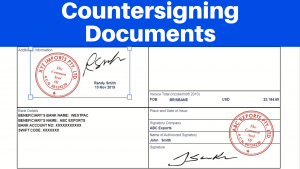The Transportation of Hazardous Goods
When transporting hazardous goods worldwide, it’s crucial to ensure a high level of safety. This is where the International Maritime Organization (IMO) comes into play. The IMO was established to create a standardized set of rules for shipping, ensuring the safety of both the maritime environment and its workers.
Part of this safety initiative led to the creation of Dangerous Goods classes. These classes categorize goods based on their specific hazards, from flammable materials to toxic substances.
By classifying these goods, supply chain parties can more effectively communicate risks and ensure that products are handled, transported, and stored safely. The IMO and the Dangerous Goods classes were established to provide a safer, more unified approach to maritime transportation to protect people, property and the environment.
Quick navigation to the 9 IMO Classes
International Maritime Organization and the International Maritime Dangerous Goods (IMDG) Code
When transporting dangerous goods and pollutants by sea, there are two main International conventions that regulate this.
First, there is the International Convention for the Safety of Life at Sea, which is usually referred to as SOLAS. Then there is the International Convention for the Prevention of Pollution from Ships, known as MARPOL.
Both SOLAS and MARPOL have detailed sections that have been combined to create the International Maritime Dangerous Goods (IMDG) Code. Think of this code as the rulebook for safely transporting these risky goods and pollutants by sea. As of 1st of January 2004 the IMDG Code became a mandatory requirement.
Dangerous Goods Classes
For all modes of transportation, whether by Road, Rail, Air or Sea, the categorization of Dangerous Goods is based on the type of risk they present. The UNITED NATIONS Committee of Experts on the Transport of Dangerous Goods decides on the classification of Dangerous Goods classes.
A summary of the 9 Dangerous Goods Classes is provided as below. In addition to these main classes, there are also several divisions and packing groups within these classes to further specify the nature and degree of danger. When classifying DG products, you should always seek professional advice.
Class 1: Explosives

Dangerous goods classified under Class 1 are explosives. These are materials or items that have the potential to explode, posing serious risks if not handled correctly. This class includes a variety of substances and objects that can produce a dangerous amount of heat, light, sound, gas, or smoke when ignited or activated. Due to their explosive nature, these goods require special care during transportation and storage to prevent accidents.
Here are the subclasses of Class 1, along with brief explanations:
- 1.1: Mass Explosion Hazard
Substances in this category can cause a mass explosion, which means that if one part of the load explodes, it is likely to cause the entire load to explode. This subclass includes very sensitive explosives with a high risk of detonation. - 1.2: Projection Hazard but not a Mass Explosion Hazard
These are explosives that pose a significant risk of producing dangerous projectiles but are not likely to produce a mass explosion. They include items like grenades and certain types of ammunition. - 1.3: Fire Hazard and Either a Minor Blast Hazard or a Minor Projection Hazard or Both
This subclass includes explosives that predominantly produce fire or a combination of fire and a minor blast or projection hazard, such as certain types of fireworks and display pyrotechnics. - 1.4: Minor Explosion Hazard
The items in this category present a minor explosion hazard and are primarily a fire risk. The explosion effects are largely confined to the package, and there is no significant projection hazard. Examples include certain types of sparklers and small ammunition. - 1.5: Very Insensitive Explosives with a Mass Explosion Hazard
These are very insensitive substances that have a mass explosion hazard. They are less sensitive to impact or friction and require significant energy to detonate, like some types of industrial explosives. - 1.6: Extremely Insensitive Articles
Substances in this subclass do not have a mass explosion hazard. These are extremely insensitive items that do not have a probability of accidental initiation or propagation, ensuring a high level of safety.
Dangerous goods labels for explosives
For Class 1 (Explosives), the labels and placards used for transportation and handling are distinct and each represents a specific subclass. Here’s a brief description of the labels for subclasses 1.1 to 1.6:
- Label 1.1 (Explosives with a mass explosion hazard): This label features an orange background with black text and an image of an exploding bomb. It indicates that the material can produce a mass explosion, which affects almost the entire load instantaneously if ignited.
- Label 1.2 (Explosives with a projection hazard): Similar in design to Label 1.1, this label also has an orange background and an image of an exploding bomb. However, it specifically indicates that the explosive material poses a projection hazard but not a mass explosion hazard.
- Label 1.3 (Explosives with predominantly a fire hazard): This label has an orange background and depicts an exploding bomb and a flame, indicating that the material presents a fire hazard and either a minor blast or a minor projection hazard, or both.
- Label 1.4 (Explosives with no significant hazard): The label shows an orange background with an image of an exploding bomb. It signifies that the explosive poses a minor hazard, with the effects mostly confined to the package itself, without significant projection.
- Label 1.5 (Very insensitive explosives with a mass explosion hazard): This label is similar to Label 1.1 but is used for very insensitive substances that have a mass explosion hazard. The design includes an orange background with an image of an exploding bomb, indicating its explosive nature but with a high degree of insensitivity to external stimuli.
- Label 1.6 (Extremely insensitive articles): This label features an orange background with an image of an exploding bomb, similar to the other labels in this class. However, it is used for items that are extremely insensitive and do not have a mass explosion hazard. The label indicates that these materials pose the least amount of risk within the explosives class.
Class 2: Gases
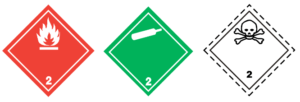
Class 2 in Dangerous Goods is about gases. This category encompasses various gases that can be compressed, liquefied, or pressurized into a solution. These gases differ significantly in their characteristics and dangers. While some are prone to catch fire, others, though not flammable, can be toxic or cause suffocation. This class is broadly segmented into three key subdivisions:
- 2.1: Flammable gases
These gases are easily ignitable and can burn quickly. They are a fire hazard and need careful handling. Common examples include propane and butane. - 2.2: Non-flammable, non-toxic gases
These gases do not catch fire and are not poisonous. However, they can displace oxygen in the air, creating a suffocation risk. Nitrogen and helium are typical examples. - 2.3: Toxic gases
These gases are harmful or lethal when inhaled. They pose significant health risks and require strict control measures. Chlorine and ammonia are common toxic gases in this subclass.
Each type poses unique risks, making proper handling and transportation crucial for safety. This class is essential in industries ranging from medical to manufacturing, highlighting the importance of understanding and respecting their potential dangers.
Dangerous goods labels for gases
Class 2 gas labels are essential for safety, clearly indicating the type and hazard of the gas. They play a crucial role in preventing accidents during transport and storage. Their standardized design ensures quick recognition and compliance with safety regulations.
- Label 2.1 – Flammable Gases: The label for flammable gases features a flame symbol. It’s predominantly red, signaling the danger of fire. The label also includes the number “2” at the bottom, indicating it’s a Class 2 gas.
- Label 2.2 – Non-Flammable, Non-Toxic Gases: This label typically shows a gas cylinder symbol. It has a green background, distinguishing it from flammable and toxic gases. Like the flammable gas label, it also displays the number “2” at the bottom.
- Label 2.3 – Toxic Gases: The toxic gas label is marked with a skull and crossbones symbol, indicating its poisonous nature. The label’s background is usually white with the number “2” at the bottom, alerting to the specific class of danger.
Class 3: Flammable Liquids

Class 3 Dangerous Goods are Flammable Liquids. They can catch fire at temperatures of 60.5°C (141°F) or lower. These liquids are either naturally liquid at room temperature or heated for moving. They are widely used in many industries. Since they can easily ignite, moving and handling them must follow strict safety rules. This is to avoid fires and explosions.
Dangerous Goods labels for Flammable Liquids
- General Flammable Liquid Label: This label has a flame symbol and the number “3.” It’s used for a variety of liquids that can easily catch fire, marking them as Class 3.
- Combustible Label: Marked with “Combustible,” this label is for liquids that can ignite, especially when heated. It also displays the number “3,” classifying it under Class 3.
- Gasoline Label: Specifically for gasoline, this label includes the word “Gasoline” and the number “3.” It highlights gasoline’s high flammability and its classification in Class 3.
- Fuel Oil Label: This label, with “Fuel Oil” on it, is for oils that can burn. Though not as volatile as gasoline, they are still flammable. The label shows the number “3,” indicating its Class 3 category.
Class 4. Flammable Solids or Substances

Class 4 Dangerous Goods are categorized as Flammable Solids or Substances. These materials are known for their ability to ignite easily under specific conditions. They include a variety of substances that can burn, react dangerously when wet, or combust spontaneously. The handling and transportation of these goods require careful attention due to their potential to cause fires. Class 4 is divided into specific subclasses to address the varying nature of these flammable solids.
- 4.1: Flammable Solids
This category includes solids that ignite easily and continue to burn or smolder, such as sulfur, zinc powder, and metal powders. These materials pose a fire hazard during handling and transportation and require careful packaging and storage to prevent accidental ignition. - 4.2: Spontaneously Combustible Solids
Materials in this subclass can ignite spontaneously upon exposure to air. Examples include phosphorus and certain types of coal. They are a significant fire risk, especially when stored or transported in large quantities, necessitating special precautions to keep them isolated from air. - 4.3: Dangerous when Wet
This group consists of substances that react with water, releasing flammable gases, like sodium, potassium, and calcium carbide. They can ignite or explode upon contact with water, thus requiring dry and secure storage conditions.
Dangerous goods labels for Flammable Solids
- The General Flammable Solids Label (4.1) This label is characterized by a vertical red stripe with a flame symbol and the number “4” at the bottom. It is used to identify materials that are easily ignitable and capable of burning rapidly, such as matches or sulfur. The presence of this label indicates that the substance requires careful handling due to its flammable nature, alerting handlers to the potential fire hazard.
- The Spontaneously Combustible Label (4.2) Featuring a half white (above) and half red (below) background, this label includes a flame symbol in the white portion and the number “4” at the bottom. It is designated for materials that can ignite spontaneously under normal conditions, like certain types of coal or phosphorus. This label is a critical warning that these substances can combust without an external ignition source, necessitating special precautions during storage and transport.
- The Dangerous When Wet Label (4.3) The label for this subclass is blue, displaying a flame symbol and the number “4.” It is used for substances that react dangerously with water, such as sodium or potassium, which can produce flammable gases or even ignite upon contact with water. The blue label serves as a warning of the specific hazard these materials pose when they come into contact with water, highlighting the need for dry storage conditions and careful handling.
Class 5: Oxidizing Agents and Organic Peroxides
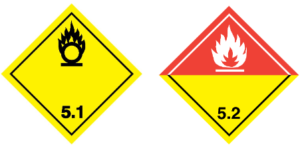
Class 5 Dangerous Goods consist of Oxidizing Agents and Organic Peroxides. These substances are known for their ability to release oxygen and enhance the combustion of other materials. They are crucial in various industrial applications but pose significant risks due to their reactive nature. Handling and transporting these substances require strict safety measures to prevent fires and explosions. Class 5 is divided into two subclasses, each with specific characteristics and hazards:
- 5.1: Oxidizing Agent
This subclass includes materials like hydrogen peroxide and nitrates, known for their ability to cause or intensify fires by releasing oxygen. Although not necessarily combustible themselves, these agents can accelerate the burning of other materials. Their storage and handling require careful control to avoid dangerous reactions, particularly with flammable substances. - 5.2: Organic Peroxides
Organic peroxides are compounds containing a bivalent -O-O- structure, making them derivatives of hydrogen peroxide. They are highly reactive, sensitive to impact or friction, and can burn rapidly. Commonly used in polymerization processes, these substances need to be managed in controlled environments due to their instability.
Dangerous goods labels for Flammable Solids
- The label for Subclass 5.1 (Oxidizing Agents) features a flame over a circle symbol, signifying the oxidizing nature of the substance. It is marked with the number “5.1,” identifying it as an oxidizing agent.
- The label for Subclass 5.2 (Organic Peroxides) displays a flame symbol to indicate their reactive and combustible nature. This label includes the number “5.2,” specifying it as an organic peroxide within Class 5.
Class 6: Toxic and infectious substances
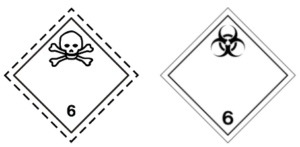
Class 6 Dangerous Goods are categorized as Toxic and Infectious Substances. These materials are known for their potential to cause serious health risks, including disease and toxicity, when humans or animals are exposed to them. Class 6 substances are divided into two main types: Toxic substances, which are harmful or fatal if inhaled, swallowed, or absorbed through the skin, and Infectious substances, which contain pathogens that can cause diseases. The handling and transportation of these substances require stringent safety measures to prevent exposure and contamination.
- 6.1: Toxic, poison substances
This subclass comprises materials known to be toxic to humans, posing health hazards during transportation. These substances, including materials like tear gas, can cause extreme irritation and require careful packaging and handling to prevent exposure. They must be clearly marked to indicate the presence of toxic materials. - 6.2: Infectious substances
These are substances containing pathogens such as bacteria, viruses, and other microorganisms capable of causing diseases in humans or animals. This category includes medical wastes, cultures, and patient specimens, which must be transported in secure packaging to avoid leakage and spillage. Infectious substances are further classified based on their disease-causing potential, with Category A being the most severe.
Dangerous goods labels for Class 6 Toxic and infectious substances
- The label for Subclass 6.1 (Toxic Substances) typically features a skull and crossbones symbol, alerting to the toxic nature of the contents. It includes the number “6.1” for classification.
- The label for Subclass 6.2 (Infectious Substances) displays the biohazard symbol, indicating biological risk. It is marked with the number “6.2” for subclass identification.
Class 7: Radioactive Substances

Class 7 Dangerous Goods are categorized as Radioactive Substances. These materials are known for emitting radiation that can be harmful to both humans and the environment. They include a range of substances, from medical isotopes to nuclear waste, and require specialized handling and transportation. The risks associated with these materials include radiation exposure and contamination, making safety protocols and proper containment essential. Class 7 materials are subject to strict international regulations to ensure they are transported safely.
Class 7 does not have formal subclasses like other classes, but it includes various types of radioactive materials, each with specific handling requirements:
- These materials can range from low-level radioactive substances used in medical and research applications to highly radioactive materials like spent nuclear fuel.
- The handling and transportation of these materials require specialized containers and safety measures to shield and contain the radiation.
- The level of radioactivity and the form of the material (whether it’s sealed or unsealed, for example) determine the specific transportation and handling requirements.
- Regulations for Class 7 materials are detailed and specific, focusing on preventing radiation leaks and ensuring safety for handlers and the public.
Dangerous goods labels for Class 7 Radioactive Substances
- Labels for Class 7 materials feature the trefoil radiation symbol, clearly indicating the presence of radioactive material.
- These labels also provide information about the radioactivity level, typically indicated by Roman numerals I, II, or III, with III representing the highest level of radiation.
- Additional details on the label may include the specific type of radioactive material, a transport index that indicates the degree of radiation hazard, and emergency contact information.
- The presence of these labels is crucial for alerting handlers and the public to the nature of the materials and the necessary safety precautions.
Class 8: Corrosive substances
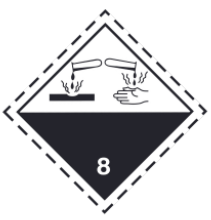
Class 8 Dangerous Goods are identified as Corrosive Substances. These materials, either liquids or solids, can cause severe damage to human skin upon contact and can also severely corrode metals like steel and aluminum. The class includes a wide range of substances, such as acids and bases, which are essential in various industrial processes but pose significant risks due to their corrosive nature. Handling and transporting these substances require careful consideration to prevent harm to people, property, and the environment. Special packaging and segregation are necessary to avoid dangerous reactions, especially when different corrosive materials are transported together.
Dangerous goods labels for Class 8 Corrosive substances
- The label for Class 8 Corrosive Substances features a symbol depicting material dripping from a test tube onto a hand and a metal surface, clearly indicating the corrosive nature of the contents.
- It typically has a white background on the top half and black on the bottom half, with the corrosion symbol prominently displayed.
- The label also includes the number “8” to denote its classification as a corrosive substance.
- This label is crucial for alerting handlers and the public to the corrosive nature of the materials and the need for appropriate safety precautions during handling and transportation.
The management of Class 8 Corrosive Substances is critical to ensure safety and prevent damage or injuries, with regulations and labeling playing a key role in communicating hazards and handling requirements.
Class 9: Miscellaneous

Class 9 Dangerous Goods are a diverse group known as Miscellaneous Dangerous Substances and Articles. This class includes materials that present various hazards during transportation but do not fit neatly into other specific hazard classes. It encompasses a wide array of substances, such as environmentally hazardous materials, magnetized materials, and items that are hazardous due to elevated temperatures. These goods also cover materials that can cause extreme annoyance or discomfort, potentially affecting the performance of duties in confined spaces. The variety within this class necessitates careful handling, labeling, and transportation to ensure safety.
Dangerous goods labels for Class 9 Miscellaneous
- The Class 9 label is easily identifiable by its seven vertical black stripes on the top half and the number “9” prominently displayed at the bottom.
- The label’s background is typically white, providing a clear contrast to the black stripes.
- It is used for a range of materials, including environmentally hazardous substances, which pose a risk to the environment, and magnetized materials, which can interfere with navigation and transportation equipment.
- The design of the label serves as a warning to handlers and transporters about the diverse and potentially unusual risks associated with these materials, signaling the need for special care during handling and transportation.
The management of Class 9 Miscellaneous Dangerous Substances and Articles is critical, given the variety of materials it includes and their potential impact on safety, the environment, and transportation systems. The labeling is essential in communicating the specific nature of these hazards and the necessary precautions for their handling and transport.
Globally Harmonized System of Classification and Labelling of Chemicals (GHS)
The Globally Harmonized System of Classification and Labelling of Chemicals (GHS) was introduced to globally unify the classification and labelling of chemicals.
Before the GHS, countries over the world had their own systems to classify and label chemicals, which was confusing and potentially dangerous.
To address this, the United Nations introduced the GHS as a way to standardize the classification and labeling of chemicals across the globe. Through the GHS, chemicals are classified based on their health, physical, and environmental hazards.
It also establishes universal symbols and phrases to ensure that, no matter where you are, the risks and safety precautions associated with a chemical are clear and consistent.
Frequently asked questions about Dangerous Goods
Who Provides the IMO Declaration?
The shipper or consignor provides the IMO Declaration. This document is needed for shipping dangerous goods by sea. It shows that the goods follow the rules of the International Maritime Dangerous Goods (IMDG) Code.
The shipper fills out the declaration. It includes details about the cargo, its hazard class, and the shipping name. This helps the carrier and authorities handle the goods safely.
Without the declaration, the shipment cannot move. It proves that safety and legal steps are followed. Carriers use it to ensure safe transport and meet global rules.
How long is a dangerous goods certificate valid for?
The validity of a dangerous goods certificate typically ranges from 2 to 3 years, depending on the issuing authority and the specific training program. Renewal usually requires undergoing refresher training or re-examination.
How to get dangerous goods license?
To obtain a dangerous goods license, enroll in a certified training course specific to the type of dangerous goods you’ll handle. After completing the course, pass the required examination. Training courses are offered by accredited institutions or organizations recognized by relevant transportation safety authorities.
Who classifies dangerous goods?
Dangerous goods are classified by regulatory bodies such as the International Maritime Organization (IMO) and the United Nations Committee of Experts on the Transport of Dangerous Goods. These organizations establish guidelines based on the nature and risk of the materials.
Why do you need dangerous goods declaration?
A dangerous goods declaration is essential for compliance with legal and safety regulations. It provides detailed information about the nature and hazards of the goods, ensuring that carriers and handlers are aware of the risks and can take appropriate safety measures during transportation.

